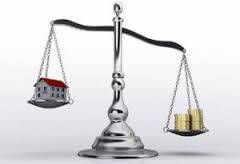What is negative gearing?
Negative gearing occurs when the expenses associated with an investment, including interest on the money borrowed, are greater than the income derived from the investment.
[Gearing itself simply refers to the act of borrowing money to invest.]
Typical investment assets subject to negative gearing arrangements, are property (particularly rental property); and share portfolios.
Satisfying this test means that you are making an income loss on the investment: a loss that is generally tax deductible. Because the loss is tax deductible, your overall tax liability is reduced. This helps to reduce the effect of the loss on your cash flow. [It is prudent to remember that when financial expenses are incurred, each dollar spent will only save a maximum of the investor’s marginal tax rate: somebody on a 42 Cents in the dollar tax rate, will still be ‘out of pocket’ by 58 cents on each dollar of loss in these circumstances.]
In the long-term, negative gearing only works if total returns from the investment, including capital growth, are greater than the accumulated short-term income losses. However, if capital growth does not occur, you may be worse off than before you started. [It should also be remembered that the imposition of capital gains tax on the eventual – and critical – gain in the asset value will erode some of any gain realised.]
Whilst negative gearing can be an effective means of increasing returns on your investments, it also carries with it the risk of increasing your losses. Careful consideration and planning should be undertaken before you borrow to negatively gear.
How does negative gearing work?
Most private investors think of negative gearing in relation to residential property. However, other income producing assets, particularly shares and share trusts, can be negatively geared with very favourable results over the long-term.
The following example illustrates the way negative gearing works. The investor has $100,000 to invest but can borrow $200,000 (at 8 per cent interest per annum), thus giving a total of $300,000 to invest. Investment income is returned at 4.5 per cent and the investor’s marginal tax rate is 46.5 per cent (including the Medicare levy).
Results
| No gearing | Negative gearing | |
| Total investment | $100,000 | $300,000 |
| Investment income | $4,500 | $13,500 |
| LESS interest paid on borrowings | $0 | ($16,000) |
| Taxable income/(loss) | $4,500 | ($2,500) |
For the investment with no gearing, the after-tax income will be $2,407. The negatively geared investment has a loss of $2,500. This will provide a tax saving of $1,163, reducing the after-tax loss to only $1,337: but beware – the actual loss will vary according to the marginal rate of tax you are able to ‘save’.
Although negative gearing may produce a loss on a year to year basis, it is necessary to look at the long-term view to show the overall effects that a negative gearing strategy may have on an investment.
After ten years, assuming investment growth at 8.5 per cent per annum and income of 4.5 per cent, the investments are cashed in and the following results are obtained. We have assumed that all income is reinvested over the ten year period and the investor utilises the 50 per cent CGT discount.
| No gearing | Negative gearing | |
| Value of investment | $339,500 | $1,018,400 |
| LESS capital gains tax | ($36,500) | ($110,000) |
| LESS borrowings repaid | $0 | ($200,000) |
| LESS initial investment | ($100,000) | ($100,000) |
| Net return | $203,000 | $608,400 |
In this situation, negative gearing has produced significant financial benefits.
What are some guidelines for negative gearing?
If you are considering negative gearing, you should keep in mind the following simple guidelines to ensure you achieve the desired results:
- Negative gearing is a long-term investment strategy.
- Ensure you can continue to pay the interest on the loan if the income from your investments falls. (This will probably necessitate having some income protection/ salary protection insurance in place.)
- Consider gearing into investments which produce tax-effective income such as shares and property securities.
- Make sure you can make your interest payments if you are unable to work – income protection insurance is essential in this regard.
- Seek expert advice to ensure your gearing strategy is appropriate for your individual circumstances and requirements.
- Consult your tax adviser to ensure the strategy is compatible with other aspects of your taxation planning situation.
Continuum Financial Planners can help…
The experienced advisers at Continuum Financial Planners Pty Ltd are able to advise in relation to Negative Gearing as a strategy: call our office (on 07-34213456) or complete the contact us form on our website, to arrange an appointment with one of our experienced advisers to discuss the relevance and benefit of the strategy in your circumstances.
We acknowledge the resources of Securitor Financial Group Limited in drafting the majority of the detail in the above article: it has been extracted from the Support Information to advice documents. [Originally posted in January 2010, it has been updated/ refreshed from time to time, most recently in March 2017.]


